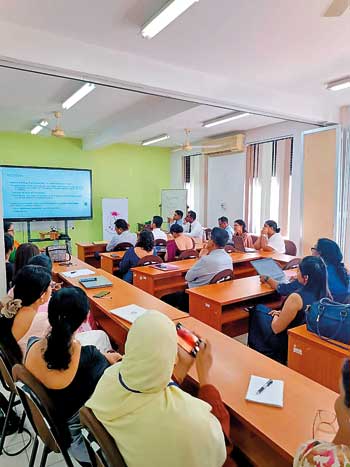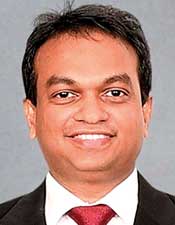News
Education and special children
No words were needed – the emotion and expressions of the mothers with special children said it all.
In their battle against many odds to integrate their children as adults with dignity in a sadly discriminatory society, one major factor is education. It is to discuss this burning issue that they gathered recently with hope, for an advocacy meeting at the Family Health Bureau auditorium in Colombo.

Crucial meeting of all stakeholders to discuss the education of special children
‘Better education opportunities for all’ was organised by the Sri Lanka Association for Child Development (SLACD), the first multi-disciplinary professional organisation in the country dedicated to child development and disability.
This meeting brought together all stakeholders including the essential education authorities for the common good of special children.
While SLACD President Prof. Aruna De Silva guided the meeting, an SLACD founder member & Past President Prof. Hemamali Perera gave an overview about the association.
Consultant Community Physician Dr. Dilini Vipulaguna who is the Clinical Lead at the Ayati National Centre for Children with Disabilities spoke on the ‘Current situation in Sri Lanka’ and the Assistant Professor of Disability Studies in Education at Columbia University’s Teachers’ College, Tamara Handy on ‘Experience from an international perspective’.
Before delving into the existing educational policies for children with special needs Consultant Paediatrician and SLACD Secretary, Dr. Imalke Kankananarachchi, focused on real-life.
The little one was five-year-old Nimali* with subtle dysmorphic features (different facial features) and global developmental delay. This indicated a delay in at least two of four developmental domains: gross motor skills (walking, running, climbing); fine motor skills (writing, drawing); speech, hearing & language; and social behaviour.
She had been diagnosed with epilepsy and was on anti-epileptic medication. She could walk independently but had frequent falls when running and struggled to climb the stairs. She could hold a pencil and draw straight lines but not a circle. Her speech was limited to a few words or short phrases.
She came from a home where both parents were graduates, working in the IT departments of private banks. She was attending a nearby preschool and was looked after by her grandparents in the afternoons, until her parents returned from work. The family was seeking guidance on how best to proceed with her education and schooling.
Dr. Kankananarachchi explained that the options for the parents were a leading National School in the region; a primary school close to their house; an international school or a ‘special school’. The issues they grappled with included a decision whether Nimali should be educated at home. If not, should the child attend a ‘normal school’ and a ‘normal class’ or a ‘special class’ and if it is the former option, should there be a ‘shadow’ teacher?
The existing documents which could serve as a guide to the parents had been unearthed by this Paediatrician after an exhaustive search. They included:
- An Education Ministry circular and instructions issued in December 2020.
- A UNICEF document on ‘Disability-Inclusive Education Practices in Sri Lanka’ in August 2021.
- A Circular and Guidelines on Special Education Assessment by the Education Ministry in September 2022.
- A Master Plan for Inclusive Education being developed by the Education Ministry in September 2023.

Dr. Imalke Kankananarachchi who has done a thorough study of relevant documents
“The current plan for the education of special children based on existing documents covered identification and registration of the child, assessment and selection of an educational plan,” he said, explaining that these children included already followed-up patients, those identified by School Committees and those identified by the Public Health Midwives (PHMs) who were following the Handbook of the Family Health Bureau issued in 2009.
Raising a valid point that the ‘Circular and Guidelines on Special Education Assessment 2022’ was 110 pages which was tedious to pore over, he said that the assessment was conducted by the Zonal Assessment Committee for Special Education (ZACSE). Its five-member team comprised the Deputy/Assistant Director of Education – Special Education; Deputy/Assistant Director of Education – Primary Education; Teacher Advisor in Special Education/Senior Teacher in Special Education; Teacher Advisor in Primary Education; and Senior Teacher in Special Education.
The classification of children with disabilities covered – Autism Spectrum Disorder (ASD), Global Developmental Delay, Intellectual Disability, Brain Injury, Deafness or Hearing Impairment, Blindness or Visual Impairment, Multiple Disabilities, Down Syndrome and other syndromes recommended by Paediatricians, Orthopaedic Impairment, Specific Learning Disability (SLD), Emotional Disturbance, Deaf-Blindness, Speech or Language Disorder and Other Health Impairment eg. Attention Deficit Hyperactivity Disorder (ADHD).
This is while those who could refer children to the ZACSE were: clinicians, parents/guardians, teachers, detention homes and probationary institutes, non-formal education divisions and Provincial Education Resource Centres.
The institutions conducting these assessments were Zonal Education Assessment Centres, the Inclusive Education Department of the National Institute of Education, the Weniwelkola ‘Shishyoda’ National Institute on Special and Inclusive Education, the Maharagama Autism Child Development Centre, the Assessment Centres established by the Provincial Departments of Education and the Provincial Education Resource Centres.
The main responsibility of the Special Education Assessment Committee is:
- Make recommendations and direct necessary actions to ensure that every child referred to the Assessment Committee is provided with appropriate educational opportunities. The committee should work in cooperation and coordination with health, social services, childcare, probation, women and child affairs, Divisional Secretariats and local government bodies.
Next Dr. Kankananarachchi dealt extensively with the types of assessment laid down by the Education Ministry, marks given at the end of the common assessment form and placement of the child based on the marks.
Here is the placement plan, as set out by the ministry:
- Score 0-25 – Register at the nearest school or under a Mobile/Field Teacher with one teacher being assigned to visit and teach three students.
- Score 26-50 – Should be enrolled on the admission register of the school at the time of completing 4 years of age on January 31st each year to provide education in an assisted special school/government special school or a special education unit of a school with a special education unit.
- Score 51-75 – The child should be integrated to Grade 1 by bringing the level of proficiency as necessary using teachers.
- Score 76-100 – These children should be admitted to Grade 1 as stated in the Circular and Guidelines of the Ministry of Education, No. 37/2020 dated 03.12.2020.
However, the Special Notes which accompanied the plan stated that recommendations should not always be based on scores alone. Gross motor, soft motor skills etc., may/may not be indicated depending on the deficiency of a particular child. Then the child’s overall score may decrease. But if the child’s intellectual ability is at a normal level, recommendations should be given to that child to receive general education opportunities and what facilities are needed to minimize the weakness.
Discussions Dr. Kankananarachchi had in Galle had found that some Medical Officers of Health (MOHs) and midwives were not aware that children with disabilities should be registered at 3 years of age, while Paediatricians had not been aware of such an assessment method, even though a Community Paediatrician had said that it was known.
There had also been confusion over the system, with a PHM indicating that they were under the impression that special children were being handled and assessed at hospital paediatric clinics, he said, adding that responses from a Deputy Director of Education were that every year he had been sending a letter to the Provincial and District Health Services Secretaries but only one MOH had sent a list of children with disabilities in 2024.
“We do not have mobile teachers,” he had further said, adding that they conduct the ZACSE every Wednesday but only three children can be accommodated because of time constraints. The main mechanism for referrals was through school principals and that was for children older than 5 years.
What, however, is the reality at ground level, asked Dr. Kankananarachchi. “Are we happy with current guidelines?”
The answer was crystal clear from Nimali’s situation………she had never had a referral to the ZACSE and her parents were not even aware of such a pathway.
Therefore, the dire need is to identify the challenges with regard to education for special children promptly, strengthen the mechanisms already in place and implement strategies to take them forward.
(* Name changed to protect identity)
The best way to say that you found the home of your dreams is by finding it on Hitad.lk. We have listings for apartments for sale or rent in Sri Lanka, no matter what locale you're looking for! Whether you live in Colombo, Galle, Kandy, Matara, Jaffna and more - we've got them all!

